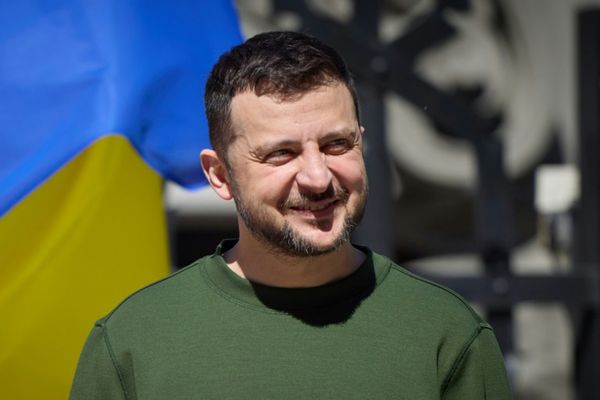
Louis, a life coach from San Diego, was dying of late-stage pancreatic cancer in 2020. His wife, Mary, tended to him with worried love. He was only forty-four years old.
Mary told us how she helped him with medications, food, and appointments. She admired and supported his resilience and good nature. But she also grew increasingly irked by Louis’s fascination with Joe Dispenza, a former chiropractor who allows himself to be called a neuroscientist by the many alt-med platforms that host him and who promises followers they can cure their diseases through breath work and meditation.
Mary had always loved Louis’s credulity, his willingness to think the best of people. She trusted that he was getting some kind of relief she couldn’t quite name from this influencer she described as having a God complex. But it didn’t sit right.
Louis had introduced Dispenza to Mary before his cancer diagnosis upended their lives. They used his recorded meditations to help them fall asleep. As Dispenza droned on in what Mary described as a megachurch style, she got creeped out and asked Louis to shut him off. Now that he was ill, she worried that this newfound obsession could hurt Louis while he navigated the perils to come. By her lights, Dispenza was camped out in Louis’s mind at a vulnerable time, offering garbage in the form of hope.
Mary (we’re withholding surnames for privacy) told us she had always had a science brain, but she wasn’t completely closed off to spirituality. She’d taken a yoga teacher training course. As a certified applied psychologist, she was clear on the researched value of positive thinking. Louis, on the other hand, had always placed New Age spirituality and far-out health ideas at the centre of his life. She used to joke that he had a real master’s degree—an MBA from Duke that made her a proud girlfriend and wife—and then his fake master’s in spiritual psychology from a New Age degree mill called the University of Santa Monica, which gave her a permanent case of side-eye.
At USM, Louis learned a little about Freud and Jung and a lot about Akashic Records: tarot, yoga, meditation, and how to recall past lives. He also completed a certification program in conscious, radiant health and healing, which he believed had helped him heal an injured knee without surgery. On their first date, Mary snooped through his bookshelf and spotted Psychology for Dummies. “Was that your course textbook?” she asked. The ribbing didn’t kill the date. Within months, like a positive and negative charge of mystic rationalism, they married. But they had only a few months together before Louis started quickly losing weight.
Pancreatic cancer has a tragically low survival rate. Initially, Louis fared well with his conventional treatment. The labs were encouraging, and the specialists urged him to stay the course. But the advice he was really hooked on came from people like Dispenza and the meditations he taught, based in part on his 2014 book, You Are the Placebo, in which he describes healing his six vertebrae that were shattered in a bicycle crash by refusing surgery and spending hours a day using a higher intelligence to visualize his spine knitting itself back together. According to Dispenza, accessing this quantum field of matter allowed him to dispense with medical advice and think his bones back into wholeness. He dubs the process “becoming your own placebo.” It’s a nonsense phrase that translates to “You can become an inert substance that has no medical effect but could fool you temporarily into feeling relief from symptoms.”
Everything that Mary knew about Dispenza came through the eyes of Louis, who felt he needed him. That aspirational view chafed against Mary’s knowledge that if he was going to make any miraculous recovery, it would be by focusing on the very worldly plan laid out by his oncologist. Louis disagreed. “I was able to heal my knee,” Mary remembers Louis saying about the meditations, “so I should be able to heal this.”
Joe Dispenza’s affable vibe and hopeful content has helped him play a major role in the normalization and domestication of a spiritual pseudoscience that looms large on mainstream platforms like Facebook. He is a middle-class Italian American Gen X boy who, according to his own account, got along with his mom and dad. He wears nice tailored shirts. He succeeds with an efficiency unknown to boomer cult leaders, who always had the pressures of brick and mortar overhead. All Dispenza needs is an inflow of attention that drives up subscriptions. He is now just another part of a social media experience.
In December 2020, Dispenza visited Aubrey Marcus’s podcast studio and summed up why he thinks his magic works. “Science has become the contemporary language of mysticism,” he said. “And if you can combine a little quantum physics with a little neuroscience with neuroendocrinology with psychoneuroimmunology, the mind body connection, epigenetics—all of those sciences point the finger at possibility.” They might. Unfortunately, Dispenza has no clinical training or experience in any of these subjects to be able to say for sure. He graduated from Life University in Marietta, Georgia, in the mid-1980s with a degree in chiropractic. In 2002, Life University lost its accreditation with the governing chiropractic regulators. A report from the time said, “Life students were not being taught how to detect and deal with problems that require medical attention.” Students were taught that all underlying causes of illness come from subluxations, a term used by “straight” chiropractors (those who focus solely on skeletal adjustments) to denote a partial or full dislocation of a joint or organ—and which, they say, cannot necessarily be observed by X-rays. It’s a bunk theory.
“If you talk about religion,” Dispenza continued, “if you talk about culture, if you talk about tradition, even spirituality, I notice that you divide the audience. But science in that sense creates community.”
It’s a sneaky argument, given the popular impression that science culture is cold and inhumane. It’s a way for Dispenza’s scientific notions to be validated by the good vibes of a charismatic event. Science that feels that good must be science done correctly, right? Dispenza’s mishandling of scientific language conceals the fact that his in-person events play out like tent-revival faith healing, where he practises laying on hands and promises women his meditations can cure their infertility and participants weep and praise God. The mirage of science and respectability also made it difficult for someone like Mary to completely dismiss him when Louis was in his hour of need. So when he wanted to go to one of Dispenza’s intensive healing events, during the peak of a COVID-19 wave—in Florida, no less, which at the time had some of the most lax protections in place for the immunocompromised—Mary gave him her blessing and hoped that participants would be masked and that he would keep track of his medications.
Louis went for a week. Mary managed waves of anxiety as she imagined the participants unmasked and hugging each other in faith-healing ecstasies. While we don’t know what exactly Louis’s week looked like, her fears were reasonable.
Aubrey Marcus opened his December 2020 podcast episode featuring Dispenza with an account of how much he’d enjoyed a recent Dispenza retreat in Cancún, which at the time didn’t have COVID travel barriers in place. Dispenza corroborated Marcus’s praise by describing the altar calls at his events, where people testify to being instantly healed of cancer. “We bring children in at the end of the event and we heal them of really serious health conditions,” he said.
“Our community gets closer,” he said. “You get people opening their heart. Love bonds; you can’t not bond in love. You have to hug, you have to connect, you have to bond.” He told a story of a woman spontaneously cured of Parkinson’s disease in front of 1,500 people.
“When you see that person,” Dispenza said, “stand on the stage and tell that story—just like an infection can spread amongst the community and create disease, all of a sudden health and wellness are as infectious as disease.” He described one woman who arrived at the event with severe allergies. At the beginning, she was wearing a mask and a ventilator.“In the middle of the event, she’s in the front of the room, dancing around with no mask, no nothing. You start seeing people freeing themselves from their own limitations.”
Such infectious “healing” can be costly. Attendance fees for similar events run at around $2,299 per person, before accommodation.
Louis’s return home wasn’t smooth. He told Mary that he was considering freeing himself from the limitations of chemotherapy. He had his meditations from Dispenza, and he was feeling better. Ironically, feeling better was most likely the result of having had to delay a chemotherapy treatment while he’d been away.
“Outside of him actually dying,” Mary told us, “it was the most devastation I’ve ever felt.” On the one hand, Mary said, it was like Louis was giving up. But giving up on what? “I think that there was a mixed feeling,” Mary said. “I think he wanted to believe that this meditation was working, because he didn’t want to be sick anymore.”
Louis was definitely ready to give up on chemotherapy nausea. Mary knew that the meditation was less painful, more hopeful. That it offered some kind of existential relief, even though, she said, he could beat himself up about not doing it for long enough. When he did manage to meditate, however, it might have allowed him to give up on living in a way that limited shame and demoralization.
If Dispenza’s meditation had simply been religious in nature, if it had been about accepting death or gratitude or setting one’s moral affairs in order, that would have been one thing. But pseudoscience isn’t honest in that way. It’s one thing pretending to be another. Dispenza was promising healing, spontaneous remission. The former chiropractor, who calls himself a doctor, was giving Louis cover for giving up on real doctors. Dispenza was also giving Louis permission to pretend he was healing himself, with some kind of dignity, even while he was saying goodbye.
In line with the probabilities, Louis’s condition worsened. “I saw how at peace he was at the end of his life,” she told us. “He was okay. He was content. He wasn’t angry.” Mary felt that he knew he was saved.
Looking back, Mary’s sorrow at Louis’s death has become layered with another mourning. “All of these beliefs carried him to that place,” she said, referring to a spiritual imagination she could never sustain. “I wish I believed the things that he believed. I wish I believed that he was sitting here next to me. I wish I believed those things, because it’s really hard to know that you’re never going to see someone again.”
“If there was something that would bring me to believe,” she said, remembering how Louis faded away into grace, “I would think it would be this. And it didn’t.” Mary stands where many people stand now, and will stand in the future, as they negotiate with friends and family members who get drawn into the sphere of the Dispenzas. Mary loved a person she knew intimately but didn’t entirely understand. She loved a person whose framework for reality became an island he could not leave and she could not visit. She accepted his unstable beliefs because she knew that giving up those beliefs would have hollowed Louis out in his time of need.
Through the chaos of a year dominated by cancer, Mary improvised a wisdom, by the skin of her teeth, that has taken seasoned therapists in the cult recovery movement decades to distill. No matter what a person believes, the wisdom goes, nor how harmful it might be to them, the best thing you can do is to love them in a way that an influencer or cult leader never could. To love them without expectation or false promises.
If there’s some universal source of pain that people like Dispenza pretend to soothe, it is loneliness. That loneliness can curdle into isolation and slowly deprive a person of the ability to trust in medicine, governments, the democratic process, and fellow citizens. If Dispenza accelerates that process for people like Louis, they have to be shown that there are more stable forms of love and care.
Dispenza can’t keep his promises, but a real friend and partner can, and that’s where rebuilding social trust might begin.
Excerpted from Conspirituality: How New Age Conspiracy Theories Became a Public Health Threat” by Derek Beres, Matthew Remski, and Julian Walker. Copyright © 2023 Derek Beres, Matthew Remski, and Julian Walker. Published by Random House Canada, a division of Penguin Random House Canada Limited. Reproduced by arrangement with the publisher. All rights reserved.







